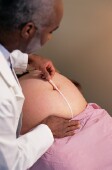- Understanding the Connection Between Anxiety and Depression
- How Daily Prunes Can Influence Cholesterol and Inflammation
- When to Take B12 for Better Absorption and Energy
- Epsom Salts: Health Benefits and Uses
- See What Saffron Can Do for Sleep and Heart Health
- 6 Common Mistakes to Avoid Before Your Physical
- Can Sweating Really Help You Beat a Cold?
- Strengthening Your Relationship: Practical Strategies
- Skip Storing This Everyday Product in the Fridge Door
- Green Tea + B3 Pairing May Boost Brain Health
Too Many Younger Teens Still Getting Pregnant: CDC


Despite a drop in teen birth rates in recent years, too many girls under 18 are still getting pregnant, U.S. health officials said Tuesday.
Even though births to teens aged 15 to 17 have declined, a quarter of teen births occur in this age group — nearly 1,700 a week, according to the U.S. Centers for Disease Control and Prevention.
“There have been noted declines in births to teens, and that’s good news,” Ileana Arias, principal deputy director of the CDC, said during a noon news conference.
“However, we can’t be complacent when we hear about these declines. We still need to make more progress in reducing health disparities and the public health burden related to teen pregnancies and births. Younger teens still account for one in four teen births,” she said.
Arias noted that pregnancy and birth can interfere with finishing high school and can lead to sacrificing education, career and income.
“The young teen years are a critical time when a teen, especially a young woman, could jeopardize her future if she cannot complete high school or go to college,” she said.
Young fathers may also have to limit their education and defer their plans, Arias said.
Speaking at the news conference, Lee Warner, the CDC’s associate director for science in the division of reproductive health, said that in 2012 there were 86,423 births to teens aged 15 to 17.
Warner said more sex education is needed for both girls and boys, and that health professionals can provide information about the best methods of contraception.
Report findings include the following, specific to teens aged 15 to 17:
- The rate of births dropped by more than half from 1991 to 2012 — from 38.6 births per 1,000 teens to 14.1.
- Birth rates were higher among Hispanic, black and American Indian/Alaska Native teens.
- In 2012, the birth rate per 1,000 teens in that age group was 25.5 for Hispanic teens, 21.9 for black teens, 17 for American Indian/Alaska Native teens, 8.4 for white teens and 4.1 for Asian/Pacific Islander teens.
- Most female teens aged 15 to 17 (73 percent) have not yet had sex.
- Most of these girls have spoken with their parents or guardians about sex, but only about four in 10 received information both on birth control and how to say no to sex.
Other findings include:
- More than 80 percent of teen girls who have had sex had no prior formal sex education.
- More than 90 percent of teens used some type of contraception the last time they had sex, but most relied on the least effective method — condoms alone.
Other CDC reports found:
- Racial and ethnic disparities in teen pregnancy rates exist. This suggests the need for culturally appropriate education and services.
- Sexually active teens are at risk for pregnancy because they use less-effective contraceptives.
- Sex education given early may help teens abstain from sex or use effective birth control.
- Parents and guardians can help preteens and teens avoid risky sexual behaviors.
Dr. Rani Gereige, director of medical education at Miami Children’s Hospital, said several factors might contribute to the problems of teen pregnancy, especially in minorities.
“Lack of education is the problem,” he said. “This includes education from parents, teachers and health care providers.”
In addition, there may be cultural reluctance to talk about sex, Gereige said. “Communication needs to start early in the preteen years before the teen initiates sexual activity,” he said.
“It is also about empowering young girls to take care of their bodies and delay sexual activity and/or use contraception if they decide to become sexually active,” Gereige said.
The lack of access to appropriate, confidential health care may also be a barrier for teens seeking information about sex, he said.
Gereige was clear that access to contraception does not encourage sexual activity.
“It allows pregnancy prevention for teens who decide to be sexually active,” he said. “The morning-after pill may help, but what helps more is education on delaying sexual activity and/or using contraception.”
More information
For more facts on teen births, visit the U.S. Department of Health and Human Services.
Source: HealthDay
Copyright © 2026 HealthDay. All rights reserved.










